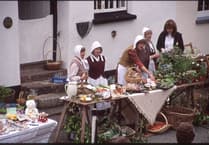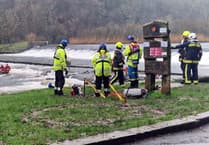Dartmoor Air Crashes — Aircraft lost in World War Two
by Robert Jones
THE consequences of the air war over Devon are the subject of this well-researched book by Robert Jones.
Describing Dartmoor as the last wilderness in southern England, it gives details about the aircraft that crashed there during World War Two. What is surprising is the total comes to more than 40.
Illustrated with photographs, it has accounts of more than two dozen accidents involving the aircraft that came down on the slopes of Dartmoor.
Despite involving British, American and German forces, all cases are treated in the same 'matter of fact' manner. Although it was a time of war, only a few of the crashes came about because of enemy action, but with many, it seems the weather played a large part.
The following chapters deal with a variety of aircraft that came to grief on the moor during the war; from one of the oldest fighters then in the RAF, a Gloster Gladiator biplane, to the loss of two of the very latest twin engine Westland Whirlwinds that crashed 'somewhere near Princetown'.
There is an account of what caused a high flying German reconnaissance plane to come swooping down to earth at Scorriton.
One of the saddest tales is about a Liberator bomber of Coastal Command returning from a long patrol over the Bay of Biscay. There is a full explanation as to why it should have come down in a field by Plasterdown as the crew struggled to make an emergency landing.
Undoubtedly some of the stories are tragic, but they are nonetheless fascinating.
They show how fate can play a part in the outcome – sometimes for the better, but not always.
There are tales of amazing escapes, like the one about the crew of an American Flying Fortress returning heavily damaged from a bombing raid on Lorient. Then there is the piece about what happened to Basil Browne, a 19-year-old RAF sergeant and how he happened to be on an American weather plane that crashed above Bridestowe on Christmas Day, 1943.
There is also an epic account of how the quarrymen at Meldon ventured out in appalling weather to look for the crew of a Wellington bomber that had crashed 'somewhere up on the high moor'.
There is a whole chapter devoted to Harrowbeer, the only operational air station on Dartmoor.
Built early in the war, the airfield was home to a number of fighter squadrons. There are details about the aircraft and pilots who came down on the moor while flying from the airfield. It concludes with an explanation as to why the President of the United States should have paid a flying visit to Yelverton.
At the end of the book there is a list of the casualties. Some of them survived to fly again, but sadly many did not.
What is amazing was their ages — the oldest was only 27.
They came from all walks of life and from all over the globe. The majority of RAF crews were volunteers coming from as far away as New Zealand and Canada.
Robert Jones is an ideal person to write about these things.
An avid moor walker, he knows even the remotest parts of Dartmoor.
Born in Plymouth during the Second World War, he flew Tiger Moths at Roborough and was secretary of the Dartmoor Gliding Society.
He has made hundreds of flights over the moors, sometimes flying over the places he writes about. As a pilot himself, he understands the problems faced by the airmen who flew across Devon during the great conflict.
As the author points out, the accounts are not about the glory of war, nor are they about the folly of war.
They are, quite simply, about the consequences of war. But it should be added they also give us an insight into some of Devon's recent history.
Robert Jones will be signing copies of his book at Bookstop, Tavistock, tomorow (Friday) at 11am.
Copies available from local bookshops and other outlets or from http://www.paulrendelldartmoor.co.uk">www.paulrendelldartmoor.co.uk



